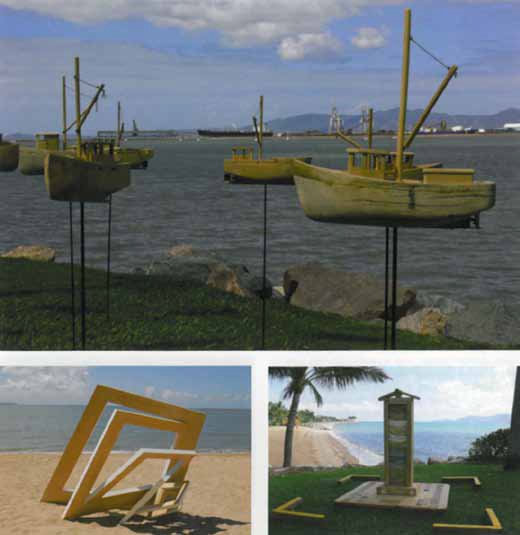The Strand Ephemera 5
The Strand, Townsville

Townsville’s main promenade, The Strand, was once again the setting for the biennial Strand Ephemera, an exhibition of temporal works of public art. On balmy clear nights we found many people exploring the parklands, looking for the twenty-two artworks which were spread out over the 2.2 km beachfront parklands. Temporal public artworks are a particular genre. They require skill to achieve a site responsive work within a limited time and budget. They often rely on the quality of an idea or site interaction more so than the quality of material or finish. Strand Ephemera places public art at the nose of everyday residents who take their daily walks along The Strand. It would be interesting to know how many locals had followed the trail of art installations, but had never visited the City Gallery.
This year’s event featured a smaller number of works than in prior Strand Ephemera. The Perc Tucker Gallery organised the event and curated three pieces. One of the points of focus this year has been to increase public interactivity. A comprehensive children’s education programme and numerous artists’ workshops were thus a feature. Well produced booklets and excellent teacher notes allowed the public to understand the artworks and to follow the trail with ease.
The curatorial process involved artists submitting proposals for artworks twelve months prior to the event. Twenty-two artists were awarded a $1,000 commission to assist with implementation, and artists were invited to facilitate children’s and artists’ workshops and public talks. Sponsorship included the shipping container by a local shipping broker.
Dominating attention by virtue of its size and coppery detail, a giant crayfish named Ray The Cray clambered up a boulder groin beside the beach, with antennae flapping in the wind. In contrast, a number of smaller pieces such as Quarantine (1+2), by Barbara Pierce, captured interest with its museum-like container display of quarantined materials and fabrics.
Fishing Trawlers by Allan Valentine is another intimate piece which was curated by Perc Tucker Gallery. Seventeen model-like timber fishing boats borrowed the ocean background and simulated a flotilla of fishermen. According to Allan who was installing the artworks one morning, “the boats are not metaphors: If anything, they are similes”. Less successful nearby was Pierre the French Bulldog / Buster / Rover, a series of three corten laser cut dogs. Their orientation and location near other unrelated objects meant that they appeared lost and looking for their owners. Observer of the Moon by Matthew Staples also looked lost without a moon, although in the short time when the moon would align into the viewfinder it would be a nice moment. The Bather by Alison McDonald is a delicately made metal figurine of an elderly lady perched on a picnic bench, made of brazed cup hooks; the piece has a doily-like detail created by the circular rotating patterns of the hooks. FINish enDANGER by Candace Mile, a series of shark fins, and Pink Piano by Jan Hynes were both popular but seemed too obvious in their implementation and ideas. Ab aeterno by Turkish artist Faith Semiz was at home on the sand. One of the more rigorous pieces it is an exploration of modernism and sits like a futurist mariner’s nautical instrument.
A single digital work, A Roaring Ocean video installation played inside a shipping container (Dark Day at Sea by Jenny Fraser). The projected artwork was intentionally disturbing, but would have created more impact if it had been located
on the beach, rather than on an island of turf near the toilets. A sound-based piece, Listen. Now Walk, was a first for Ephemera, with Sydney based artists Vic McEwan and Sarah Moor producing a sophisticated cultural interpretation of
Townsville. MP3 sticks and headphones were available to the public, and locations of stories and speculations were numbered along The Strand. The artwork required at least a half hour of participation and perhaps could have been
shorter, since most people on The Strand are on the move. This work would be suitable as a permanent cultural/interpretive piece to enliven Townsville’s hidden culture to new visitors. Strand Ephemera differs from other temporal public art events such as Swell Sculpture by the Sewa in Currumbin. Whilst both events are focussed around physical works, Swell’s pieces are often larger and more robust, perhaps a reflection of intent for artworks to be placed in
a permanent location after the event. Strand Ephemera has a sense of being truly temporal in nature, reflecting its intent and name. Temporal public art festivals by the beach are emerging as important cultural markers in the life of regional cities. Their impact on the general public’s perception of public art is not well surveyed. Virginia Rigney, Curator Public Programs from Gold Coast City Art Gallery, who walked The Strand with me one morning, suggests that a post-event survey or a comparative research of two or three events would be very revealing about this emergent art practice.
Strand Ephemera enlivens The Strand, which is a beautiful walk populated by a clutter of less than beautiful park objects, signs and walls. Strand Ephemera does not seem to have inspired a renaissance of permanent public art or public space improvement in Townsville’s city centre: perhaps this is enough public art for the city in the minds of the city leaders?
Strand Ephemera has however succeeded in activating Townsville by providing cultural and artistic interventions in the everyday life of its citizens. This year’s event shows increasing curatorial confidence and more thoughtful temporal works. Future events could take more risks and perhaps incorporate even more interactivity and public challenges for the promenading public.

